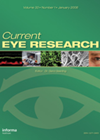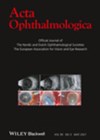
Journal Reviews
Current concepts of the uveitis-glaucoma-hyphaema (UGH) syndrome
The authors discuss pathophysiology, aetiology and current management strategies of UGH syndrome. The clinical features of UGH are different than initial descriptions. UGH today is most often associated with posterior chamber IOLs that are not placed within the capsular bag...
Diplopia after cataract surgery – risk factors
The risk factors for binocular diplopia after uncomplicated cataract surgery in adults were studied to analyse the patterns of ocular motility and clinical causes. This was a retrospective review of 40 patients; 25 female. Onset of diplopia was at a...
Microdroplet and splatter contamination during phacoemulsification in COVID-19 era
Half a millilitre of fluorescein was incorporated into 400ml of balanced salt solution to identify microdroplet and splatter from phacoemulsification to simulate possible COVID-19 contamination. Five porcine eyes were mounted to an ophthalmic mannequin head and two surgeons (height 189cm,...
Biometric changes in phakic eyes over time
This was a single-centre retrospective cohort study of patients who attended a ‘two-stop’ preassessment clinic for consideration of cataract surgery between November 2002 and March 2015. Four biometric measurements were recorded: axial length, horizontal (K1) readings, vertical (K2) readings and...
Wet AMD outcomes post cataract surgery
The authors present the findings of a retrospective study looking at the progression of wet age-related macular degeneration (AMD) in patients who underwent cataract surgery. They recruited a series of 111 patients of which 38 were men and 73 were...
Topical nonsteroidal ant-inflammatory drugs (NSAIDs) in patients undergoing cataract surgery
Inflammation is a major risk factor for the development of cystoid macular oedema (CMO) after cataract surgery, leading to breakdown of the blood-retina barrier. There is a correlation between severity of CMO and level of postoperative inflammation. Laser flare meter...
Practical application of cataract risk stratification
This study assessed the practicability of a risk stratification system, the New Zealand Cataract Risk Stratification (NZCRS) in a major teaching hospital. The scoring system was as follows: three points for Dense cataract, pseudoexfoliation (PXF), phacodonesis, previous vitrectomy and only...
Cystoid macular oedema following cataract surgery
This review covers the history, incidence, diagnosis, risk factors, pathophysiology and medical management of postoperative macular oedema (PCMO), with a particular emphasis on key contemporary studies and novel observations. The authors revisit the incidence of well-established risk factors including intraoperative...
Effect of cataract surgery on inflammation control and vision in uveitis patients
This retrospective longitudinal study from Moorfields, London, UK compared uveitis recurrence rates and vision loss in 309 eyes of uveitis patients post cataract surgery to 300 control uveitis patients. Cataract is a common complication associated with uveitis and leads to...
Diclofenac versus Bromfenac after cataract surgery
Non-steroidal anti-inflammatory drugs (NSAIDs) are commonly used after cataract surgery to reduce inflammation and cystoid macular oedema (CMO). Diclofenac 0.1% is used three to five times daily for 28 days and Bromfenac 0.09% twice daily for 14 days postoperatively. The...
Temporal versus nasal clear corneal incisions
This is a prospective randomised study of 100 patients’ left eye having undergone phacoemulsification either by a 2.4mm nasal clear corneal incision (CCI) group or temporal CCI group. The corneal astigmatic changes were compared between groups by power vector analysis,...
Effect of phacoemulsification on facility of outflow
This is a prospective study to examine the change in electronic Schotz tonographic outflow (TOF) and IOP measurements after phacoemulsification. Intraocular pressure was measured using Goldman‘s applanation tonography (GAT). Data were collected at baseline, three, six and 12 months postoperatively....















